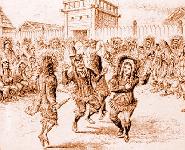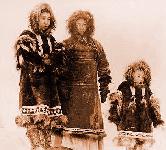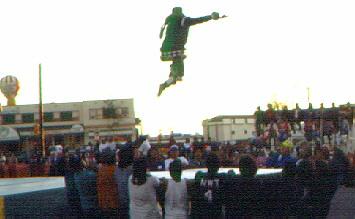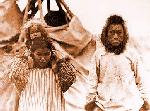
The Inuvialuit
(in detail)
by
David Morrison
Curator of N.W.T. Archaeology
(District of Mackenzie)
Canadian Museum of Civilization
Location and Population
 When
Alexander Mackenzie was led down the Mackenzie River in 1789, his Dene
guides took great care that he avoid meeting their traditional enemies, the Inuit (Eskimos)
living around the mouth of the river (Lamb 1970). In the late 18th century they probably
numbered between 2000 and 2500 people. Their largest villages, notably Kittigazuit and
Gupuk, were clustered around the East Channel of the Mackenzie, where the shape of the
river mouth facilitated beluga whale hunting (McGhee 1974; Arnold 1994). When John
Richardson of the British Royal Navy sailed by Kittigazuit in 1826, he was met by an
estimated 200 men in kayaks (Franklin 1971), suggesting that the village may have housed
as many as 1000 people during the summer beluga hunt. Smaller villages with populations
ranging from perhaps a dozen to several hundred people dotted the Arctic coast from the
present Alaskan border to Franklin Bay, up the larger rivers such as the Anderson and the
Firth, and around the shores of the Eskimo Lakes. The boundary separating these
westernmost of Canadian Inuit from their Dene neighbours to the south essentially followed
the tree line. As elsewhere, the Inuit are a people of the Arctic tundra.
When
Alexander Mackenzie was led down the Mackenzie River in 1789, his Dene
guides took great care that he avoid meeting their traditional enemies, the Inuit (Eskimos)
living around the mouth of the river (Lamb 1970). In the late 18th century they probably
numbered between 2000 and 2500 people. Their largest villages, notably Kittigazuit and
Gupuk, were clustered around the East Channel of the Mackenzie, where the shape of the
river mouth facilitated beluga whale hunting (McGhee 1974; Arnold 1994). When John
Richardson of the British Royal Navy sailed by Kittigazuit in 1826, he was met by an
estimated 200 men in kayaks (Franklin 1971), suggesting that the village may have housed
as many as 1000 people during the summer beluga hunt. Smaller villages with populations
ranging from perhaps a dozen to several hundred people dotted the Arctic coast from the
present Alaskan border to Franklin Bay, up the larger rivers such as the Anderson and the
Firth, and around the shores of the Eskimo Lakes. The boundary separating these
westernmost of Canadian Inuit from their Dene neighbours to the south essentially followed
the tree line. As elsewhere, the Inuit are a people of the Arctic tundra.
Their Many Names
They are also a people with many names. As well as their various territorial designations, anthropologists and historians have generally called them "Mackenzie Inuit" or "Mackenzie Eskimo" distinguishing them from their relatives in north Alaska and in the central Canadian Arctic (see McGhee 1974; Smith 1984; Morrison 1988). A 19th century
French missionary, Emile Petitot, said they called themselves "Tchiglit," a word of
unknown meaning (Petitot 1878). The modern inhabitants of towns like Tuktoyaktuk and
Inuvik prefer "Inuvialuit" ("real people") and that is the term used here.
central Canadian Arctic (see McGhee 1974; Smith 1984; Morrison 1988). A 19th century
French missionary, Emile Petitot, said they called themselves "Tchiglit," a word of
unknown meaning (Petitot 1878). The modern inhabitants of towns like Tuktoyaktuk and
Inuvik prefer "Inuvialuit" ("real people") and that is the term used here.
Distinctive Traits and Relationships
 Inuit are not everywhere the same, and the Inuvialuit had (and
have) more in common with their relatives in north Alaska than those in the rest of Arctic Canada. Like
Alaskans they lived in substantial log and sod houses, with cold-trap entrances and
elevated sleeping platforms. Especially in the larger coastal villages these houses were
often multi-family dwellings shaped like gigantic clover leafs, with a family sleeping in
each of the three alcoves, sharing a common living area in the middle. They also built large
community structures called karigi, where dances and religious activities took place. Their
social relations were less egalitarian than those of central Arctic Inuit. Their chiefs, called
umialiq, were rich and powerful men whose positions were at least partially hereditary
(McGhee 1974; Morrison 1988).
Inuit are not everywhere the same, and the Inuvialuit had (and
have) more in common with their relatives in north Alaska than those in the rest of Arctic Canada. Like
Alaskans they lived in substantial log and sod houses, with cold-trap entrances and
elevated sleeping platforms. Especially in the larger coastal villages these houses were
often multi-family dwellings shaped like gigantic clover leafs, with a family sleeping in
each of the three alcoves, sharing a common living area in the middle. They also built large
community structures called karigi, where dances and religious activities took place. Their
social relations were less egalitarian than those of central Arctic Inuit. Their chiefs, called
umialiq, were rich and powerful men whose positions were at least partially hereditary
(McGhee 1974; Morrison 1988).
Traditional Economy
The western part of the Canadian Arctic is much better endowed than areas further east, and the Inuvialuit lived relatively secure, prosperous lives. Starvation was rare, a misadventure rather than a predictable consequence of late winter. Beluga hunting was important around the mouth of the Mackenzie River, while villages on the outer headlands to the east often hunted even larger bowhead whales. Net fishing was important everywhere, and seals were taken along the arctic coast. Caribou were hunted in inland regions, particularly in the foothills of the Richardson Mountains west of the Mackenzie, and in the Eskimo Lakes - Anderson River area to the east. The sea supplied abundant driftwood, so useful for building houses, boats, sleds, and innumerable tools. It was even sometimes burnt as fuel, something no Central Arctic Inuit would dream of doing.Territorial Groups
 In the late 19th century the Inuvialuit were divided into five distinct territorial
groups, each named after its largest village (McGhee 1974). Examples include the
Kittegaryumiut, or "people of Kittigazuit," and the Nuvorugmiut, or "people of Nuvurak" (a
village at Atkinson Point, on the Tuktoyaktuk Peninsula). These groups were largely
endogamous (that is most marriages took place within groups, rather than between them),
and relatively hostile to one another. In earlier times, oral history and archaeology suggest
that two other territorial groups existed. One lived around Franklin Bay, an area which was
abandoned (perhaps due to disease) in the middle 19th century (Morrison 1990). The other
lived around the Eskimo Lakes, and was dispersed or driven away by the Kittegaryumiut,
who took over their lands, apparently just before the time of European contact (Morrison
and Arnold 1994).
In the late 19th century the Inuvialuit were divided into five distinct territorial
groups, each named after its largest village (McGhee 1974). Examples include the
Kittegaryumiut, or "people of Kittigazuit," and the Nuvorugmiut, or "people of Nuvurak" (a
village at Atkinson Point, on the Tuktoyaktuk Peninsula). These groups were largely
endogamous (that is most marriages took place within groups, rather than between them),
and relatively hostile to one another. In earlier times, oral history and archaeology suggest
that two other territorial groups existed. One lived around Franklin Bay, an area which was
abandoned (perhaps due to disease) in the middle 19th century (Morrison 1990). The other
lived around the Eskimo Lakes, and was dispersed or driven away by the Kittegaryumiut,
who took over their lands, apparently just before the time of European contact (Morrison
and Arnold 1994).
Relations with their Southern Neighbours
Despite mutual discord, all Inuvialuit shared a greater hostility to the Indian groups living to the south of them. Inuvaluit and Dene distrusted one another and share a history of violence, of raid and counter-raid, extending back for centuries. At Saunaktuk on the Eskimo Lakes archaeologists have unearthed evidence of a massacre of more than 20 people, mostly women and children, which has been radiocarbon dated to the 14th century (Morrison and Arnold 1994). It is still remembered in oral histories, which report a Dene attack on an Inuvialuit village at a time when the men were all away hunting. Inuvialuit were not always the losers; indeed historical accounts from the early 19th century suggest that the Dene feared them more than they feared the Dene. And the mistrust was never total; the two groups traded with one another and there were even individuals who were bilingual in Inuvialuktun and Gwich'in.Contact, Trade and Disease
Inuvialuit contact with Europeans began indirectly in the late 18th century. Alexander Mackenzie was the first to enter their territory. He never met them, but he did report (via Dene informants) that the Inuvialuit were already receiving Russian iron ware from Alaskan Inuit traders at this early date (Lamb 1970: 208). Later they traded with Mackenzie River Dene for Hudson's Bay Company goods, and by 1850 were trading directly with the HBC at Fort MacPherson. By the late 1860s, a visitor reports that 300 or 400 Inuvialuit were visiting the post each trading season (Morrison 1988: 4-8).They received more than trade goods. The first infectious diseases may have hit the Inuvialuit as early as the 1840s, caught from Hare Indians with whom eastern Inuvialuit were trading (Morrison 1991). A better documented epidemic (perhaps measles or scarlet fever) struck in 1865, followed three years later by "typhus or some nervous fever" (see Morrison 1988: 8). By 1889, when the whalers arrived in the western Arctic, the Inuvialuit population was already in serious decline.

The blanket toss is a traditional Inuvialuit activity seen here being performed during the1992 Arctic Summer Games held in Inuvik.
With the arrival of the whalers this decline became precipitious. The whalers were American, based in Seattle, and between 1889 and the beginning of the First World War they book about 1500 bowhead whales from Canadian waters (Bockstoce 1986). Because of the distances involved they usually over-wintered in the Western Arctic, particularly at Herschel Island off the north Yukon coast, where up to fifteen ships could be found most winters. This brought them into close contact with Inuvialuit, who were employed as whalemen and caribou hunters, and rewarded with a wealth of trade goods. Traditional material culture was transformed by the importation of repeating rifles, canvas tents, American clothing, whale boats, and even food supplies such as flour, tinned meat, coffee, and syrup. The pace of disease quickened, and after two particularly lethal measles epidemics in 1900 and 1902, Kittigazuit and other large traditional villages were abandoned (Stefansson 1914: 24, 349; Jenness 1964: 14). In 1905, the Royal Northwest Mounted Police reported that the Inuvialuit population had been reduced to 250 people, about 10% of what it had been a hundred years earlier. By 1910 there were only 150 (Usher 1971: 175).
At the same time as they were being decimated by disease, the Inuvialuit were also inundated by Alaskan Inuit, attracted to the Mackenzie area by the prospects of employment with the whalers and fleeing a disastrous collapse in the caribou population of their own country. They were known as "Nunatamiut" or "people of the land," since most of them came from the Alaskan interior (Stefansson 1914; Bockstoce 1986). Many of them settled in the Mackenzie Delta, where the muskrat trapping was particularly good. Here they acquired a new name, Uummarmiut, or "people of the green trees and willows," a reference to the dense vegetation of the Delta (Anon. 1991: 47).
Relations with the local Inuvialuit were sometimes less than cordial. The Inuvialuit particularly disliked the Uummarmiut practise of using poison when trapping, and used shamanic magic to keep the Uummarmiut from discovering the caribou resources east the Mackenzie River (Anon. 1991: 36; Stefansson 1914: 173). But in the long run, the two groups inter-married and merged, so that today few Inuvialuit do not have ancestors in both groups (Anon. 1991: 47). Something of the distinction between them is still preserved linguistically. There are two dialects of the Inuit language spoken in the greater Mackenzie area today (Lowe 1984). One is known as Siglitun, and is the dialect of the original, local Inuvialuit. It is the dominant dialect in Tuktoyaktuk, Paulatuk, and Sachs Harbour. Uummarmiutun, the Alaskan dialect, is spoken primarily in the Delta communities of Inuvik and Aklavik. And by the late 20th century, everyone also speaks English.
A New Balance
 In 1984, the Inuvialuit signed The Inuvialuit Land Agreement with the Federal
Government, giving them legal title over their territory. And they now number, once more,
about 2500 people, and live in modern towns and villages with frame houses,
snowmobiles, and VCRs. With the collapse of the oil industry in the 1980s employment
prospects in the Western Arctic are not good, but at least the people are once more in at
least partial control of their own destinies.
In 1984, the Inuvialuit signed The Inuvialuit Land Agreement with the Federal
Government, giving them legal title over their territory. And they now number, once more,
about 2500 people, and live in modern towns and villages with frame houses,
snowmobiles, and VCRs. With the collapse of the oil industry in the 1980s employment
prospects in the Western Arctic are not good, but at least the people are once more in at
least partial control of their own destinies.



